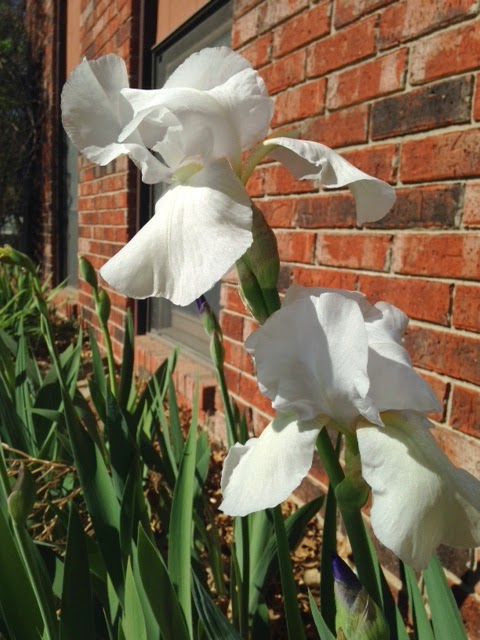I'm on a quest to do just that, keep my kitchen supplied with bread that doesn't require plastics for me to make. The recipe must be easy enough for me to not mind making it every week by hand (without a bread machine) and easy because baking is not my forte.
A good while back, I did actually reduce the amount of plastic packaging we purchase along with our bread by switching to frozen dough, which comes packed five loaves to a bag. Better than a bag with every loaf of ready-to-eat. This was a vast improvement. The fresh-baked bread is delicious, and it's convenient to keep a big store of it in the freezer.* I keep and re-use the plastic, dough bags, but there are only so many of these I need. Like the plastic, shopping bags (we no longer acquire), they tend to pile up. It's time for a new boycott, the first R of the four R`s, refuse, reduce, reuse and recycle, in that order of priority.
To that end, I'm trying recipes as I have time and motivation to do so. The latest is from a languishing blog,
Home Baked, called
Buttermilk Bread. In case that blog disappears, I'll write out the recipe here:
Buttermilk Bread
Makes 2 large loaves
2 cups lukewarm water
1 cup buttermilk
1 1/2 Tbsp. active dry yeast
1 Tbsp. Kosher salt
1 1/2 Tbsp. sugar
6 cups unbleached all-purpose flour
1 Tbsp. melted butter
Mix the water, buttermilk, yeast, salt and sugar in a 5-quart bowl or lidded food storage container. Add the flour and stir until all the flour is incorporated. (I use a large silicone spatula, but a wooden spoon works fine, too.)
Cover the bowl or container (not airtight) and let rest at room temperature for about 2 hours.At this point, you can use the dough immediately or keep it covered (still not airtight) in the refrigerator to use over the next 7 days. Sprinkle the dough with a little flour and scoop out half. Dust the piece of dough with a little more flour and quickly and gently shape it into a ball. Stretch the ball into an oval and place in a greased 9x4x3 non-stick loaf pan. The pan should be a little more than half full.
Let the dough rest for 40 minutes (or 1 hour and 40 minutes for refrigerated dough). Twenty minutes before baking, preheat the oven to 350 degrees. Dust the loaf with flour, and slash the top with the tip of a sharp knife. Brush the top with melted butter.
Bake for about 45 minutes, until golden brown. Remove from the pan and cool completely on a wire rack before slicing. Keeps well in a sealed plastic bag for about 3 days.
When I made it, I had my oven set on convection bake, and I still had to add 5 minutes to get the same golden brown that was in the blog's picture. This was also with only one loaf in the oven because I halved the recipe. With two loaves in there, it might need more time. At the point of refrigeration in the above recipe is the stage when I think I can throw the bread dough in the freezer to replicate the convenience I currently enjoy.
Of course, it's not enough to be easy and delicious. It has to reduce my use of plastic, and if the basic ingredients are purchased in a bunch of plastic containers, then I might be worse off than I was. So here's the plastic count based on what is currently available to me.
2 cups lukewarm water
0 units of plastic.
1 cup buttermilk
Dairy has become an issue since my grocery no longer carries milk in the fold-top paper cartons. I don't normally buy buttermilk because it might go to waste. I make it, now, with whatever milk product I have on hand and a little vinegar. The milk, whatever form, still comes with the plastic cap and a plastic ring. The vinegar, too, though in a glass bottle, has a plastic cap and ring. The vinegar's saving grace is that it will be used for many, many loaves, so many that the plastic contribution to my bread is negligible. 2 units of plastic.
1 1/2 Tbsp. active dry yeast
I buy yeast in a glass jar with a metal screw cap. 0 units of plastic.
1 Tbsp. Kosher salt
My salt comes in a paper box with a metal spout. 0 units of plastic.
1 1/2 Tbsp. sugar
Sugar comes packaged in paper. 0 units of plastic.
6 cups unbleached all-purpose flour
Flour also comes packaged in paper. 0 units of plastic.
1 Tbsp. melted butter
I buy butter in sticks individually wrapped in paper, packaged in a paper box. 0 units of plastic.
My plastic unit total comes to 2, the cap and ring from the dairy, unavoidable at this point. I can rationalize this amount by claiming that the dairy is purchased for other purposes and that I'm only borrowing, but it's just as possible that I might buy milk only to make the bread. Assuming I purchase milk solely for the bread, I can buy as large a unit of milk as one gallon. That much makes 32 loaves, but that's more than I would probably bake before the milk spoils. More realistically, I imagine myself making about 10 loaves. Before, I had 2 plastic units, the bag and the bag clip, for every 5 loaves. Now I have 2 plastic units for every 10 loaves, half the plastic. Is it worth the effort of mixing my own dough bread? Only if my husband will eat it with as much pleasure as he eats the fresh-baked bread I'm currently buying as a frozen dough.
Of course, a better solution** is to find a bread that is both delicious and dairy-free. I looked online for dairy-free alternatives, but
the list doesn't look promising. The bread has to be versatile, delicious true, but sliceable and the right flavor for a sandwich or as toast.
Pending a new idea, this is my new bread. Below is a pic of the first loaf fresh from the oven. After it cooled, we sliced it and declared it superb in every way for our needs. In flavor, it was far, far better than the store-bought dough. It even had a better structure for slicing. Importantly for me, it's extremely easy to make. This will, at least, allow me to test how the process of mixing dough in batches and freezing works for me.
*Freezing is low on my list of desirable methods of food preservation. It requires a lot of energy no matter how you calculate it, and it's HIGHLY unreliable. One, sustained power outage, and all your hard work and ingredients consumed are lost. Another reason this particular bread recipe is appealing is that it is simple enough to whip up individually every few days, eliminating the freezer stage should that fail us for any reason.
**Another alternative is to use powdered milk. I can buy that in paper boxes with metal spouts. It's another direction I fully intend to try.




































